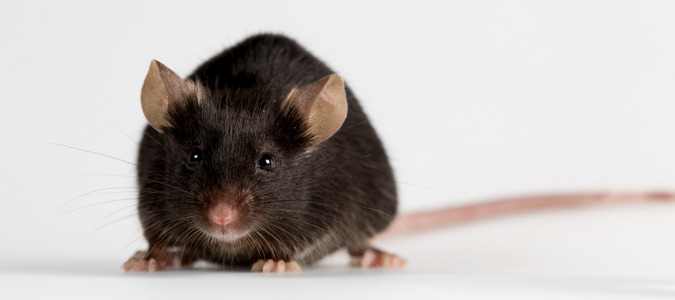If you’ve spotted black mice in your home or around your property, you’re probably wondering how to get rid of them—fast. The good news is, there is no special trick to it. Black mice aren’t a special type of mice . If you see a black mouse, it’s probably a regular house mouse with darker fur. House mice can have fur from ranging brownish to light gray, to dark gray or almost black in color.
Getting rid of house mice is similar to controlling other mouse populations. You have to use traps, close off their entry points and get rid of whatever is attracting them. The bad news is, mice can be very hard to control without professional help.
A big problem with mice is that they are very prolific. A single female house mouse has multiple babies at a time and multiple litters each year. This means she can have 30 or more babies in a single year! With lots of mice living together in a nest, it’s easy to see how their numbers can quickly grow out of control.
If you do have a mouse problem, it’s important to get it under control as quickly as possible. Mice can carry diseases and bacteria that can make humans sick, like hantavirus, leptospirosis and Salmonella.
Mice can also do lots of damage to people’s homes and property, which can be very expensive to fix. As rodents, their gnawing habits can cause many problems in a home or garage. Mice can gnaw through wood flooring and baseboards. They can even gnaw through PVC pipes and electrical wiring, posing a fire hazard.
The first step in getting rid of mice on your property is identifying what type of mice you’re dealing with. If the mouse you spotted had black fur, a small body, little round ears and black, beady eyes, it was probably a variety of house mouse. House mice are much smaller than rats. They are no more than five inches long from the tip of the nose to the end of the tail.
Identifying droppings is a common sign of mouse activity. It’s also another good way to identify what type of pest you’re dealing with. House mice lay droppings that are noticeably smaller than rat droppings. Mouse droppings are about the size and shape of grains of rice, with pinched ends.
If you have a mouse problem, you’ll probably notice one or more of the following common signs of a mouse infestation:
- Mouse droppings
- Gnaw marks on baseboards, cabinets or plastic pipes
- Chew marks on cereal boxes or scattered dry goods in your pantry
- Shredded insulation, paper or other nesting materials
- Squeaking, scratching or scurrying sounds coming from inside the wall or ceiling
Getting Rid of Mice
What Attracts Mice to Your Home?
What Do Mouse Chew Marks Look Like?
What do mouse chew marks look like? Remember that mice are rodents. Like all rodents, they have front teeth that grow continuously, so mice need to gnaw regularly to keep these teeth filed down. Mouse chew marks look like small lines or furrows, or clusters of tiny teeth.
These tiny double lines are pretty easy to identify in wood. People often notice them on baseboards, rafters and cabinets in their homes. But you can also see mouse chew marks in other spots, like on paper or cardboard boxes.
Mice can cause dangerous property damage by gnawing through electrical wiring and PVC pipes. Mice usually chew on pipes because there is water inside that they want to drink. When they gnaw holes in pipes, the holes have rough, uneven edges.
Mice aren’t trying to be destructive by seeking out wiring and pipes to chew on. They have a natural urge to chew, and as fearful, nocturnal animals, they usually hang out in dark, hidden spaces. In a home, these spaces are the exact spots where things like pipes and wires hide—hence, a mouse’s destructive habit of chewing on these items.
You might also see little scratch marks around the gnaw marks, especially in softer materials like wood. A mouse’s tiny, sharp claws make these scratches. Oily rub marks may also be visible near the gnaw marks. Mice and rats have naturally oily fur. They are also creatures of habit that typically stay close to walls as they move along well-traveled routes. The oils in their fur rub off onto the walls as they pass by repeatedly over time.
Finding mouse chew marks anywhere around your property is a definite sign of mouse activity. It can even be a sign of a mouse infestation. If you find chew marks, the best thing to do is to call a pest control professional . They can inspect your home as well as your attic, garage and any other structures, and develop a customized pest control plan.
How to Seal Mice Entry Points
If you have a mouse problem in your home, it means they’re getting inside somewhere. That means you need to know how to seal mice entry points to keep these critters out of your living space.
To mark off mouse entry points, you need to find any little gaps, holes, tears or other spots where they could get inside your house. Keep in mind that mice can fit through holes that seem impossibly tiny. They only need a quarter-inch of space to squeeze through.
Look at any faucets, pipes or vents that connect to the exterior of your home. Sometimes these have gaps around them that pests use to access the interior. Eaves are another common spot for mice entry points. So there are gaps around exterior doors and windows, or tears in the screens.
The process of closing off these openings is pretty simple. Stuff any small holes with steel wool. Cover open vents with wire mesh, as long as it is fine-gauge enough that mice can’t fit through the holes. Caulk is another option for closing small cracks and holes that pests are using to get indoors. If there are any tears in window or door screens, replace the screens. Replace any rotten wood around windows and doors if mice and other pests are getting through at these points.
A pest control professional can thoroughly inspect your home and property to identify any spots where mice could be getting in. They can close off the entry points with steel wool, caulk or wire mesh, and advise you about other measures that will keep mice away.
ABC Can Control Black Mice on Your Property
Dealing with a mouse problem can be time-consuming and frustrating. Instead of dealing with this on your own, contact ABC Home & Commercial Services. Our licensed professionals will create a customized rodent control plan, so you can feel comfortable at home again.


